The military logistics market is characterized by a complex interplay of competitive dynamics, driven by technological advancements, geopolitical considerations, and the increasing demand for efficient supply chain solutions. Key players such as Lockheed Martin (US), Northrop Grumman (US), and Raytheon Technologies (US) are at the forefront, each adopting distinct strategies to enhance their operational capabilities. Lockheed Martin (US) focuses on innovation through advanced technologies, particularly in automation and data analytics, which are crucial for optimizing logistics operations. Northrop Grumman (US) emphasizes strategic partnerships and collaborations to bolster its supply chain resilience, while Raytheon Technologies (US) is investing heavily in digital transformation initiatives to streamline logistics processes and improve responsiveness to military needs. Collectively, these strategies contribute to a competitive environment that is increasingly reliant on technological integration and strategic alliances.
In terms of business tactics, companies are localizing manufacturing and optimizing supply chains to enhance efficiency and reduce costs. The market structure appears moderately fragmented, with several key players exerting considerable influence. This fragmentation allows for a diverse range of solutions and innovations, as companies strive to differentiate themselves in a competitive landscape. The collective influence of these major players shapes market dynamics, as they compete not only on price but also on technological advancements and service reliability.
In November 2025, Lockheed Martin (US) announced a partnership with a leading AI firm to develop predictive logistics solutions aimed at enhancing supply chain efficiency. This strategic move is significant as it aligns with the growing trend of integrating artificial intelligence into logistics operations, potentially reducing lead times and improving resource allocation. Such innovations may provide Lockheed Martin (US) with a competitive edge in an increasingly technology-driven market.
In October 2025, Northrop Grumman (US) secured a contract with the U.S. Department of Defense to enhance its logistics support capabilities through advanced data analytics. This contract underscores the importance of data-driven decision-making in military logistics, suggesting that Northrop Grumman (US) is positioning itself as a leader in leveraging analytics for operational efficiency. The implications of this contract could extend beyond immediate logistics support, potentially influencing broader operational strategies within the military.
In September 2025, Raytheon Technologies (US) launched a new logistics management platform designed to integrate various supply chain functions into a single interface. This initiative reflects a growing trend towards digitalization in military logistics, indicating that Raytheon Technologies (US) is committed to enhancing operational transparency and responsiveness. The platform's success could redefine how logistics operations are managed, setting a new standard for efficiency in the sector.
As of December 2025, current trends in the military logistics market are increasingly defined by digitalization, sustainability, and the integration of artificial intelligence. Strategic alliances are becoming pivotal, as companies recognize the need to collaborate to enhance their technological capabilities and market reach. Looking ahead, competitive differentiation is likely to evolve, shifting from traditional price-based competition to a focus on innovation, technology, and supply chain reliability. This transition may redefine the competitive landscape, compelling companies to invest in cutting-edge solutions that meet the evolving demands of military logistics.




















Leave a Comment